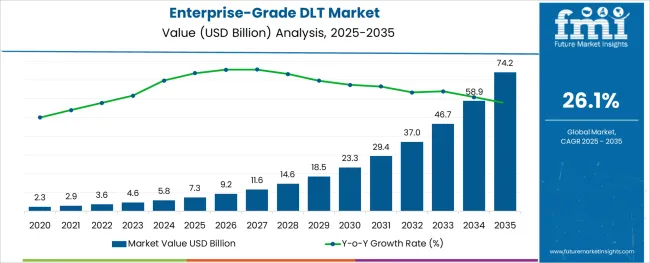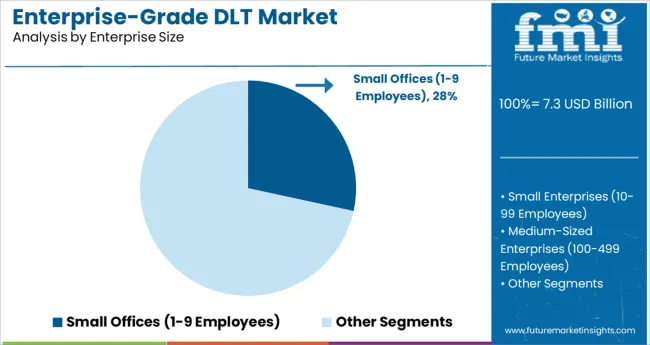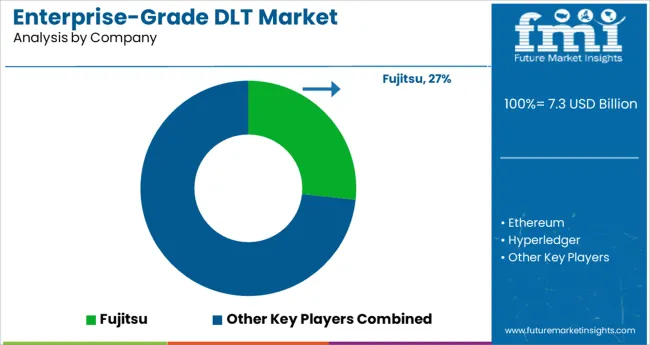The Enterprise-Grade DLT Market is estimated to be valued at USD 7.3 billion in 2025 and is projected to reach USD 74.2 billion by 2035, registering a compound annual growth rate (CAGR) of 26.1% over the forecast period.

The alginic acid market is undergoing consistent growth, propelled by rising demand from food processing, pharmaceutical formulations, and cosmetic applications. A growing focus on natural and sustainable ingredients in manufacturing processes has positioned alginic acid as a preferred biopolymer across industries.
The market is further supported by its diverse functional benefits, including water retention, gelling, and stabilizing properties, which make it indispensable in high-performance formulations. Increased regulatory acceptance of alginates as safe additives and the push towards cleaner labeling in food and personal care products have reinforced their adoption.
Ongoing innovation in extraction technologies and the utilization of algae as a renewable resource are paving the way for cost-effective production and expanded applications, ensuring sustained market expansion in the coming years.
The market is segmented by Application, Deployment Mode, Industry, and Enterprise Size and region. By Application, the market is divided into Supply Chain, Digital Identity, Payments, Smart Contracts, and Others. In terms of Deployment Mode, the market is classified into Cloud and On-premise. Based on Industry, the market is segmented into Finance, Manufacturing and Resources, Distribution Services, Services, Public Sector, and Infrastructure. By Enterprise Size, the market is divided into Small Offices (1-9 Employees), Small Enterprises (10-99 Employees), Medium-Sized Enterprises (100-499 Employees), Large Enterprises (500-999 Employees), and Very Large Enterprises (1000+ Employees). Regionally, the market is classified into North America, Latin America, Western Europe, Eastern Europe, Balkan & Baltic Countries, Russia & Belarus, Central Asia, East Asia, South Asia & Pacific, and the Middle East & Africa.
The market is segmented by Application, Deployment Mode, Industry, and Enterprise Size and region. By Application, the market is divided into Supply Chain, Digital Identity, Payments, Smart Contracts, and Others. In terms of Deployment Mode, the market is classified into Cloud and On-premise. Based on Industry, the market is segmented into Finance, Manufacturing and Resources, Distribution Services, Services, Public Sector, and Infrastructure. By Enterprise Size, the market is divided into Small Offices (1-9 Employees), Small Enterprises (10-99 Employees), Medium-Sized Enterprises (100-499 Employees), Large Enterprises (500-999 Employees), and Very Large Enterprises (1000+ Employees). Regionally, the market is classified into North America, Latin America, Western Europe, Eastern Europe, Balkan & Baltic Countries, Russia & Belarus, Central Asia, East Asia, South Asia & Pacific, and the Middle East & Africa.

When segmented by salts, sodium alginate is expected to command 27.5% of the market revenue in 2025, marking it as the leading subsegment in this category. This leadership has been driven by its superior solubility, ease of incorporation into formulations, and versatility in a wide range of applications.
Its ability to form stable gels and maintain viscosity under varying conditions has made it highly sought after in both food and pharmaceutical sectors. Manufacturers have prioritized sodium alginate due to its consistent performance, cost-effectiveness, and regulatory acceptance, which have collectively strengthened its position.
The segment’s prominence has also been enhanced by its adaptability to evolving consumer preferences for plant-derived and sustainable ingredients, reinforcing its market share.
Segmented by end user industry, the food industry is projected to hold 33.0% of the market revenue in 2025, positioning it as the most prominent sector. This dominance has been shaped by the industry’s increasing reliance on alginic acid and its derivatives to deliver desirable textures, stabilize emulsions, and improve shelf life of processed foods.
As consumer demand for clean label and natural additives has intensified, the food sector has responded by integrating alginates into bakery, dairy, and confectionery products. Enhanced production efficiency and compliance with food safety standards have further encouraged widespread use.
The segment’s leadership has also been supported by product differentiation strategies where alginates contribute to premium quality and innovation, securing their role in modern food formulations.
When analyzed by functionality, thickening agents are forecast to account for 29.0% of the market revenue in 2025, establishing themselves as the dominant functional category. This preeminence has been underpinned by the growing need for consistent texture and viscosity in a wide array of end products.
Alginic acid’s natural origin and high efficiency in creating uniform, stable thickness without altering taste or color have solidified its appeal. The demand for thickeners in both edible and topical applications has expanded, with manufacturers leveraging its rheological properties to meet performance and regulatory requirements.
The functionality’s leading share has also been reinforced by the ability to deliver cost savings through lower dosages and its compatibility with other ingredients, securing its position as an indispensable component in formulation strategies.
The enterprise-grade DLT market witnessed steady growth in the historical period of 2020 to 2024, arriving at a market valuation of USD 5.8 million by the end of 2024.
The growing government initiatives, widespread use of smartphones, and rise in the penetration of the internet propelled the market in recent years. Going forward, the market is predicted to move at a robust CAGR of 26.7% over the stipulated time period of 2025 to 2035 and is estimated to attain USD 74.2 million by the 2035 year-end.
The market is forecast to drive forward as a result of rising venture capital funding and investment in the technology, and wide application of enterprise-grade DLT solutions, including smart contracts, payment, and digital entities. Further, the surging utilization of Hyperledger, which is a DLT-based development platform for blockchain solutions providing transparency, speed, and cost-efficiency for business transactions, is projected to aid the market development over the forecast period.
Hyperledger is used in various industries, such as banking, information technology, supply chain, insurance, retail, supply chain, virtualization, finance, IoT, and manufacturing, etc. It offers modular and configurable architecture, versatility in the creation of BCT solutions for diverse use cases, a highly scalable system, and supports various DBMS for ledger maintenance.
The enterprise-grade DLT market is replete with opportunities, as the technology is perceived to offer great potential in various applications, including cybersecurity, banking, and IoT.
Extensive utilization of IoT devices in numerous applications, such as smart transportation, smart grids, smart city projects, smart homes, vehicular connectivity, and autonomous vehicles, is projected to foster market development over the forecast period. Due to the rapidly growing market of IoT devices, many enterprises are originating updated technology use cases utilizing IoT devices.
Many pioneers are implementing distributed ledger solutions for a decentralized network of IoT devices, thus eliminating the requirement for a central location to manage communications between devices. The enterprise-grade distributed ledger technology is predicted to enable direct communication between devices, consequently eliminating the need for other monitoring systems.
Various challenges that block the path for the enterprise-grade DLT market include technical issues, such as legal concerns, interoperability, standardization, and privacy. The challenge of interoperability can arise at multiple levels, at the technology level, and at the level of semantics, data models, and processes utilized in particular platforms and applications.
In addition to lack of legal clarity, lack of standards is emerging as a key challenge as the industry is moving towards digitization. On top of this, another issue of jurisdictional standardization is adding to the considerable challenge of legal systems amendment to permit trade digitization.
The supply chain segment accounted for a market share of 27.8% in 2024. The growing demand for sophisticated supply chains in complex ecosystems and markets that involve many agreements, is catalyzing the segment growth in the market.
The application of enterprise-grade DLT in the supply chain allows heightened simplicity, enhanced transparency, fraud and error prevention, tamper-proof verification, increased efficiency, and finality.
Meanwhile, the payments category is predicted to witness rapid growth over the stipulated time frame, growing at a CAGR of 28.7%. The growing utilization of enterprise-grade DLT solutions by companies to custody and shift digital assets across entities and borders to meet the capital and liquidity requirements of the firm is predicted to facilitate the demand for enterprise-grade DLT in payments.
Cloud is predicted to observe a rapid CAGR of 28.6% between 2025 to 2035. The growing adoption of enterprise-grade DLT solutions by top cloud services providers, such as AWS, Alibaba, Google, Baidu, IBM, Huawei, SAP, Oracle, and Tencent is projected to contribute towards the market development of the global enterprise-grade DLT market over the forecast period.
As of 2024, the finance industry was estimated to account for a market share of 26.5% of the overall market, on the basis of industry. The growing innovation in the market to cater to the growing requirement to enhance private data privacy is anticipated to drive the adoption of enterprise-grade DLT solutions in the financial services industry.
Medium-sized enterprises are predicted to grow at the fastest CAGR of 28.7% in the upcoming years. The surging adoption of enterprise-grade DLT services owing to an emerging interest in distributed ledger technology for secure financial transactions is predicted to boost the growth of the enterprise-grade DLT market.
North America enterprise-grade DLT market accounts for 29.8% of the overall market share. The market growth in the region can be attributed to the early adoption of enterprise-grade DLT services and the availability of various vendors that offer security and DLT solutions are anticipated to propel the regional market growth.
Furthermore, the surging implementation of security and risk management solution by businesses residing in the region to provide data security, safety against cyber-attacks, and commercial surveillance, to enable business continuity is projected to boost the market growth.

Enterprise-grade DLT solutions are employed to either better the existing businesses or unlock new business opportunities. The surging use- cases for DLT are emerging every day, thus propelling the market development. Technological support is required by enterprises while developing, managing, and maintaining solutions.
Many players offer technological as well as architectural support for developing enterprise-grade DLT solutions. Hyperledger, Ethereum, R3- Corda, Ripple, ERIS, Insolar, Multichain, etc., are but a few of the enablers of DLT services and solutions.
Fujitsu opened FUJITSU Track and Trust Solution Center, an international enterprise blockchain in Brussels, Belgium in 2020. The Solution Center is dedicated to the firm’s commitment to distributed ledger technology and blockchain as a means to transform the way enterprises and consumers buy, exchange, and sell goods and services.
The Center also enables organizations to modify their operational and commercial models. The Solution Center is in charge of research with outer partners, uniting on particular projects to together explore DLT’s potential beyond financial services.
The global enterprise-grade dlt market is estimated to be valued at USD 7.3 billion in 2025.
It is projected to reach USD 74.2 billion by 2035.
The market is expected to grow at a 26.1% CAGR between 2025 and 2035.
The key product types are supply chain, digital identity, payments, smart contracts and others.
cloud segment is expected to dominate with a 63.2% industry share in 2025.






Our Research Products

The "Full Research Suite" delivers actionable market intel, deep dives on markets or technologies, so clients act faster, cut risk, and unlock growth.

The Leaderboard benchmarks and ranks top vendors, classifying them as Established Leaders, Leading Challengers, or Disruptors & Challengers.

Locates where complements amplify value and substitutes erode it, forecasting net impact by horizon

We deliver granular, decision-grade intel: market sizing, 5-year forecasts, pricing, adoption, usage, revenue, and operational KPIs—plus competitor tracking, regulation, and value chains—across 60 countries broadly.

Spot the shifts before they hit your P&L. We track inflection points, adoption curves, pricing moves, and ecosystem plays to show where demand is heading, why it is changing, and what to do next across high-growth markets and disruptive tech

Real-time reads of user behavior. We track shifting priorities, perceptions of today’s and next-gen services, and provider experience, then pace how fast tech moves from trial to adoption, blending buyer, consumer, and channel inputs with social signals (#WhySwitch, #UX).

Partner with our analyst team to build a custom report designed around your business priorities. From analysing market trends to assessing competitors or crafting bespoke datasets, we tailor insights to your needs.
Supplier Intelligence
Discovery & Profiling
Capacity & Footprint
Performance & Risk
Compliance & Governance
Commercial Readiness
Who Supplies Whom
Scorecards & Shortlists
Playbooks & Docs
Category Intelligence
Definition & Scope
Demand & Use Cases
Cost Drivers
Market Structure
Supply Chain Map
Trade & Policy
Operating Norms
Deliverables
Buyer Intelligence
Account Basics
Spend & Scope
Procurement Model
Vendor Requirements
Terms & Policies
Entry Strategy
Pain Points & Triggers
Outputs
Pricing Analysis
Benchmarks
Trends
Should-Cost
Indexation
Landed Cost
Commercial Terms
Deliverables
Brand Analysis
Positioning & Value Prop
Share & Presence
Customer Evidence
Go-to-Market
Digital & Reputation
Compliance & Trust
KPIs & Gaps
Outputs
Full Research Suite comprises of:
Market outlook & trends analysis
Interviews & case studies
Strategic recommendations
Vendor profiles & capabilities analysis
5-year forecasts
8 regions and 60+ country-level data splits
Market segment data splits
12 months of continuous data updates
DELIVERED AS:
PDF EXCEL ONLINE

Thank you!
You will receive an email from our Business Development Manager. Please be sure to check your SPAM/JUNK folder too.
Chat With
MaRIA